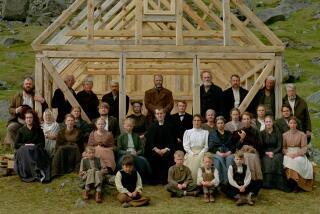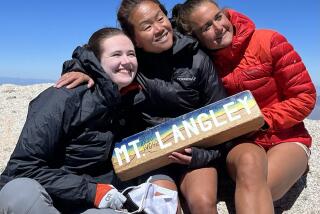Becoming one with the inner Viking
Hella, Iceland — A misty drizzle was falling again, beading on my bright orange rain pants and my horse’s thick black mane. It was cold enough to make my nose run and my toes numb. But none of that mattered once we took off at a gallop along the muddy home stretch.
Charging into the wet wind, speeding past massive hillsides and winding rivers and very startled sheep, I’d never felt as primal — or as free.
Some people come to Iceland for the culinary delicacies: decomposing shark flesh and roasted lamb testicles, for instance. Some come to groove in the funky boîtes of Reykjavik, the cosmopolitan capital. Some come just to watch the geysers and soak in hot springs.
But I came here solo last September to discover my inner Viking — on horseback.
When a friend suggested the tour atop purebred descendants of the original Viking breed, I was intrigued by the idea of riding across a landscape that’s scarcely changed in the last millennium. I had ridden horses throughout my childhood, so it struck a personal chord.
On this sparsely populated island about the size of Kentucky, just 500 miles from Scotland in the North Atlantic, dozens of horse farms offer the chance to relive Viking history.
My choice was the family-run, 250-acre Hestheimar (pronounced hest-hi-mar) farm in a bucolic hamlet called Hella, about an hour’s drive from the Keflavik international airport. Searching the Web, I had found an extensive list of riding tour operators, but the combination of cultural immersion and affordable eco-tourism made Hestheimar an easy choice for me, a fairly budget-conscious traveler seeking an authentic experience. A five-day guided expedition with more than 80 horses to ride (though you can ride the same one every day), home-cooked meals and lodging in a four-bedroom guesthouse cost about $800.
My package, booked through a company called Ishestar, included airfare and two nights in Reykjavik, which I wasted in a hotel room, given the downpour and my jet lag. Fortunately, I hadn’t come for city life.
Arriving in Hella on a crisp, damp morning, I took in the hilltop view of this glaciated landscape: Rivers snaked across grassy fields, a brown volcano (one of about 200) reached the clouds, and steam floated from holes in the ground, proof of the geothermal energy that provides inexpensive, nonpolluting heat and hot water for the island. In fact, Reykjavik means “Smoky Bay,” and the city is said to have been named after a 9th century settler’s glimpse of the steam from the hot springs.
Icelandic horses — pony-sized creatures ranging from almost white to brownish black — seemed to roam everywhere. I felt as though I had reached Tolkien’s Middle-earth, even though it is only a 5 1/2-hour nonstop flight from Washington.
Despite vestiges of the 21st century, Hella is still charmingly Viking. Like most of Iceland’s population, the people here are largely homogeneous, hailing from Nordic and Celtic stock. Neighbors still visit one another on horseback, barter animals and make moonshine. (Alcohol is heavily taxed.) Names are patriarchal: Mine would be “Hope Joels- dottir” (Joel’s daughter). And the horses are still viewed as a labor force. Most of Hestheimar’s horses don’t even have names: There’s no point being sentimental about “workers” when you have to get rid of them as they age or fail, said Matti Bonz, Hestheimar’s resident — and reticent — guide on the trails.
This is an Iceland that few tourists discover. Nearly 280,000 tourists came by plane and 30,000 more by cruise ship last year, but many limited themselves to the capital.
Reykjavik, the Geysir geothermal field (origin of the word “geyser”), the huge Gulfoss waterfalls and more than half of the country’s 272,000 inhabitants are in southwest Iceland, as is Hella, so there’s plenty to do if your riding-strained body needs an afternoon off.
Mostly, though, a week at Hestheimar is all about the horses and where they can take you.
Visitors stay in a newly built guest- house that’s bright, warm and eminently quaint. Four downstairs bedrooms, spare and clean, can accommodate eight travelers in narrow beds with fluffy comforters. Two rooms share a bath; two have private baths. A low-ceilinged loft upstairs has a couch and chairs and stacked mattresses — for the travelers with sleeping bags who invariably fill the place in summer months. There’s even a full kitchen, complete with seating for six at a wooden table, but all three meals are served in the hosts’ farmhouse up the hill.
Around 9 a.m., the guests — a Norwegian kayaking guide, his Danish-speaking wife, a Boston mail carrier and I, all there for an eco-cultural experience — had breakfast with our hosts, Asta Begga and her husband, Gisli. Their kitchen, a large, sunny space dotted with horsy knickknacks, has a windowed wall overlooking the vast green grazing field.
As we would each day, we helped ourselves to cereal, fresh brown bread and butter, sliced meat that resembled salami, apple juice and coffee. Sometimes there was a special treat: thick vanilla yogurt that Icelanders drench in heavy cream. I mentally cringed on behalf of arteries everywhere, then shook a sugary dollop — much heavier than my usual Dannon Light ‘n Fit — off a large serving spoon. Matti insisted on adding the cream, which cut the yogurt’s sweetness and made the meal more than palatable, if more than fattening.
A horse ‘to keep for memory’
After the morning repast we filled water bottles and made sandwiches for lunch on the trail. But before trotting off to the stable on that first morning, I thanked my hostess for breakfast and told her I loved it here. Asta, an always smiling brunet in her mid-30s, hugged me.“You can take a horse to keep for memory,” she joked in fairly good English. “I am sure it will fit in your home.”
She’s probably right. Icelandic horses are surprisingly small. Their eyes come just to my chest, and I’m only 5 feet 5. Triangle ears poke out from thick, brambly manes. Round bellies, propped up by four stubby legs, hang like smiles not 3 feet from the ground.
Yet true to their medieval roots, these ponies are Army-tank tough: tireless and unfaltering through rivers and jagged terrain. Arriving in wooden knarrs (Viking cargo ships) from Norway in the late 9th century, the horses adapted to life lugging barbarians, firewood and food across mountains, glaciers and neck-high waters. Though today’s Icelandic horses are used mostly for recreation, they haven’t lost their Viking pluck.
Tourists who come to ride from May to September, months of ample daylight (about 21 hours in June and nearly 13 hours by mid-September) with high temperatures in the 50s to 70s, won’t face ice fields or dangerous waters in Hella. But they will get a sense of the horses’ amazing sure-footedness while traversing pathless fields that look like masses of grass-covered bowling balls.
Rain or shine — and in the spring and fall, there’s lots of light rain — we wound through the countryside with little to offer in the way of what we often think of as sightseeing. When you live in a city, though, the boundless green fields, wild horses and placid lakes are as enthralling as the Louvre.
Sometimes we encountered frolicking sheep; at other times we incited a herd of cows to trot alongside us from behind their wire-gated confines. Nearly every day we rode for a bit along a highway, which terrified me: The thoroughbreds I grew up with would have spooked and bolted at the sound of a truck rumbling past. But nothing fazed these tiny troupers.
There were fast-moving streams to cross and slippery inclines to ride up and down. “Level ground” often meant a 6-inch-wide strip of dirt path that had been trodden by other horses navigating the tussocks.
I didn’t need to be nearly as tough as the horses to survive the week. I didn’t even need my previous riding experience, because riding these five-gaited trail horses was an entirely different game. But I did need to do some work in and out of the saddle. This was no luxury vacation.
I was grooming horses daily, which meant dirt under my broken nails, dust in my nose and horsehair on the traditional Icelandic sweater I had bought duty free. I had to hoist myself into the saddle without help, which wasn’t easy because I’m not terribly flexible anymore. But with one foot on the ground and another in the stirrup, I somehow managed to launch myself up and onto the horse.
I rode in the rain (glad for that raincoat) and through rivers that soaked my so-called waterproof hiking boots. And I rode for at least six hours a day, resulting in a sore backside the first night and sore everything else the second, which lingered throughout my stay.
Yet far from being torture, it was all part of the thrill. I discovered that inner Viking as I navigated rushing rivers and wildly uneven ground where I saw no signs of civilization. Long stretches passed without much to see besides grass, rocky hillsides, wild horses and sheep. But I found, as the Norse explorers must have, that the adventure is in the journey. Centuries later, there’s still not much to the destination. It was the quiet, the clean air, the sense of aloneness that made the journey.
The journey, however, isn’t always easy, a lesson I learned on Day Two.
Adjusting to a gliding gait
The sun was bright, the sky was clear and the ground ahead was smooth for miles. The guide picked up the pace, the other horses followed and everyone zipped along — except me.As my horse took off at a calamitous trot, my feet slipped from the stirrups, my hands clutched a wiry tuft of mane and my body bounced right over the saddle onto the withers (the little hump between a horse’s neck and back). Ouch.
Clearly I had not yet mastered the tolt, an ultra-smooth gait characteristic of Icelandic horses that is the equine equivalent of power-walking. The brisk, gliding gait can be as slow as a trot or faster than a canter. At either pace, it feels like riding a sofa.
It took me two days and a dozen ibuprofen to get it right. It was a matter of shortening my reins, leaning way back and relaxing. I remember the drizzly late afternoon when it all came together: Sitting back on my tailbone, shoulders slouched lazily, I yawned with exhaustion and gave a halfhearted kick to catch up with the guide. Suddenly I found the ground moving beneath me — yet I remained still in the saddle. I was finally tolting, and all it took was a little fatigue.
About 4 p.m. we usually returned to the stable, where I untacked and regroomed my rain-dampened, dirt-caked beast. He was set free to gallop in the field; I was free to hobble bowlegged with my fellow travelers to the hosts’ house for coffee and buttery cake.
We buzzed with post-ride exhilaration for several hours before dining heartily on home-cooked country dinners, including creamy leek soup, potato casseroles and fresh haddock, fishing being a mainstay of Iceland’s economy.
When the plates were cleared, we toasted one another, swapping riding notes and risqué jokes and stories from our homelands before retiring to the guesthouse. The next day we did it happily all over again.
You don’t need a weeklong riding excursion to experience Iceland on its native horses. Many hotels and guesthouses can arrange horseback riding day tours for a taste of the terrain and an introduction to the tolt. But these shorter tours don’t give you as much time to find your rhythm in the saddle. Or to explore vast expanses of unspoiled Viking landscape. Or to live alongside native Icelanders, soaking up the culture of their daily life. For all that, you’ll have to stay awhile.
With Reykjavik just an hour away, you can cap off your trip there — treating your taste buds to a plate of lamb testicles after all.
More to Read
Sign up for The Wild
We’ll help you find the best places to hike, bike and run, as well as the perfect silent spots for meditation and yoga.
You may occasionally receive promotional content from the Los Angeles Times.






